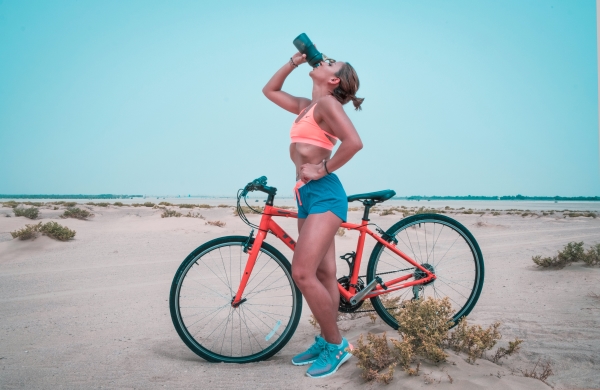
You don't have to be around bicycling very long to find out that although the bicycle is touted to be the most efficient human powered machine on the planet, it isn't necessarily user-friendly. And one of the most common ailments bike riders encounter is low back pain.
The word 'efficient' suggests a lack of wasted energy and movement, and that's just what you get when you're riding a bike. Unlike activities such as running or swimming, which may entertain a variety of wasted movements (think flailing arms, swaying hips, or excessive splashing), cycling movement is largely restricted to a relatively small amount of leg movement.
Add the fact that riding is done in a position of flexion, and you come away with some short, tight muscles...and before long you start complaining of low back pain. Why does that happen?
Beware Of The Psoas Muscle
One of the most utilized muscles in cycling is the psoas muscle (pronounced so - az). While just about everyone is familiar with the quadriceps, the hamstrings, and the gluteal muscles, this psoas muscle largely escapes awareness. That's partly due to its location.
This is a muscle that resides behind the contents of the abdomen, originating from the lumbar spine, and attaching to the femur (thigh bone). The psoas is categorized as a 'hip flexor' (a muscle that, when it contracts, 'flexes' the leg forward and up toward the abdomen...like bringing the leg forward when walking).
When we consider that most cycling is done in a position wherein the leg never fully straightens out, and then comes up very close to the abdomen at the top of the stroke, you appreciate the fact that the psoas functions largely in a shortened position. And chronically short, tight muscles become problematic.
You can see a good stretch of the psoas muscle on this YouTube video.
The Glutes Can Get Tight Too
If you spend any time riding your bike uphill, standing out of the saddle, you'll quickly become aware of the contribution your gluteal muscles make in riding a bike. This is a group of muscles that consists of the gluteus major, gluteus medius, and the gluteus minimus, and is rarely stretched adequately.
When the gluts get tight, they often get distinct tender points along the top of the pelvic bone, where they are attached. Low back pain can result.
Fortunately, deep tissue massage can effectively address these trigger points. For those of us not blessed with access to a massage therapist, rolling on the floor with a tennis ball directly over the tender spots can be a very effective treatment. Let pain be your guide...if it hurts when in contact with the tennis ball, that's an area that needs the pressure the ball is applying.
The glutes are not commonly stretched effectively, so watching this Livestrong video on how to stretch the gluts will direct you in the right way to keep these trigger points from developing to begin with.
Cyclists Are 'Quad Heavy'
Coming from a running background, it took some time to convert my legs from 'runner's legs' to 'cyclist's legs'. While running involves a lot of hamstring and calf activity, cycling is predominately a quadriceps sport.
If you want to see an exaggeration of this truth, just Google the term 'sprint cyclist' into the image search. You'll see some freaky big legs, and they'll be predominately quadriceps.
One of the tenets of exercise physiology is that a short, tight muscle muscle will end up giving you trouble somewhere down the road. In the case of tight quadriceps, there is a corresponding forward tilt of the pelvis.
n layman’s terms, tight quads increase the sway in the low back. The short, tight para-spinal muscles of the low back that result from this configuration are another source of low back pain in cyclists.
Stretching the quads is a must and isn't too complicated.
Riding a bike for recreation and fitness is an exhilarating way to go. There are so many advantages to cycling:
- The speed is unparalleled in the exercise world.
- The amount of entertaining scenery you can take in during a ride is enormous.
- The amount of time spent at an aerobic level without pounding the joints is an advantage.
But as we have already discussed, because our bodies are having to conform to the design of the bike, there are some 'overuse' muscle patterns that need to be addressed regularly. Cycling and stretching really must go hand in hand.
By easily keeping the Psoas muscles, the Gluteal muscles, and the Quadricep muscles from getting short and tight, you can look forward to many years of cycling benefits.
Happy cycling!
About the author:
Dr. Ron Fritzke is a Sports Chiropractor in Mount Shasta, California. In addition to his private practice, he is a member of the Sports Medicine team at the College of the Siskiyous. Additionally, he writes cycling product reviews covering everything from indoor bike trainer reviews to reviews of bike racks. A former marathon runner, he now uses cycling as his primary means of exercising.